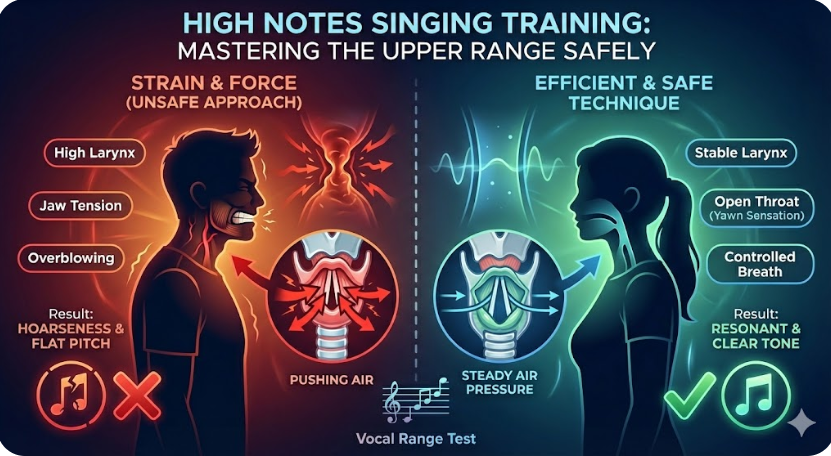Singing high notes is one of the biggest goals for most singers. Whether you want to hit soaring pop vocals, operatic high Cs, or powerful gospel climaxes, learning to sing high notes safely takes time, technique, and consistency.
This guide will show you how to reach higher pitches with less strain, using proven exercises and daily training methods trusted by vocal coaches.
Before you begin, test your starting point using the Vocal Range Calculator. It will help you track progress as your upper range expands.
Why Singing High Notes Can Be Challenging
High notes often require:
- More breath support than speaking or mid-range singing
- Precise control over vocal cord tension
- Smooth register transitions between chest, mix, and head voice
Beginners often push too hard, leading to strain or cracks in the voice. The key is learning how to use less effort while maintaining power.
How the Voice Produces High Notes
When singing higher:
- The vocal folds stretch and thin out, vibrating faster
- The sound shifts resonance from the chest to the head
- Air pressure must stay steady but not excessive
Training focuses on balancing airflow, resonance, and muscle coordination for both power and safety.

Essential Warm-Ups Before High Note Training
Never jump straight to high pitches. Always start with daily vocal warm-up exercises like:
- Lip trills (“brrr”) on comfortable notes
- Humming low → mid → high
- Siren slides from low to high
This wakes up the voice and reduces the risk of strain.
Breathing Techniques for High Notes
Breath support powers high notes, not throat tension. Use breathing techniques for singing to:
- Inhale deeply using the diaphragm
- Maintain gentle air pressure as you sing
- Release air slowly for sustained phrases
More air does not mean louder singing. It means controlled airflow for better tone.
Step-by-Step High Note Exercises
Here are proven exercises to train your upper range safely:
1. Lip Trills on Scales
- Sing “brrr” while moving up scales slowly
- Builds airflow control and keeps the throat relaxed
2. Siren Glides
- Glide from your lowest note to highest and back down on “oo” or “ee”
- Strengthens the passaggio (the break area between registers)
3. Staccato High Notes
- Sing short “ha-ha-ha” sounds on higher pitches lightly
- Improves pitch accuracy without over-singing
4. Octave Jumps
- Sing a note, then jump one octave higher on the same vowel
- Start softly, add volume only when tone is stable
5. Mix Voice Training
- Blend chest and head voice around mid-range pitches
- Prevents cracks and reduces strain on upper notes
For register blending, check chest voice vs head voice for practical tips.
6. Semi-Occluded Vocal Tract (SOVT) Exercises
- Sing through a straw or into water for gentle resistance
- Reduces tension while strengthening high-note control
Main Interactive Tools:
- Vocal Range Test – find your exact highest and lowest notes online in seconds.
- Vocal Range Calculator – measure and record your range accurately using your microphone.
- Singer Comparison Tool – compare your vocal range with famous singers and see where you align.
- AI Voice Analysis – get instant feedback on your tone, pitch stability, and clarity through advanced AI.
- Song Key Finder – discover songs that naturally fit your vocal range and tessitura.
- Ear Training Game – improve pitch accuracy and interval recognition through fun listening challenges.
- Microphone Tester – check your mic setup before testing your range or recording vocals.
Daily 15-Minute High Note Practice Routine
| Exercise | Duration | Focus |
|---|---|---|
| Breathing drills | 2 min | Airflow and support |
| Lip trills + sirens | 3 min | Relaxation, warm-up |
| Staccato high notes | 3 min | Accuracy and agility |
| Octave jumps | 3 min | Range and resonance |
| Mix voice scales | 4 min | Smooth register blending |
Keep the volume moderate. High notes should feel light and easy before powerful and loud.
Common Mistakes to Avoid:
- Forcing high notes with too much air pressure
- Singing at full volume before learning control
- Skipping warm-ups or daily practice
- Ignoring vocal fatigue or hoarseness
If your voice feels tight or strained, stop and rest.
Strengthening the Mix Voice for High Notes
Most high notes become easier when you master the mix voice — the area between chest and head voice. It:
- Reduces strain by sharing resonance across registers
- Keeps tone balanced through the passaggio
- Adds power without shouting
Training mix voice takes patience but pays off with smooth, connected high notes.
Diet, Hydration, and Vocal Health
High-note singing depends on healthy vocal cords:
- Drink plenty of water throughout the day
- Avoid caffeine and alcohol before singing
- Rest your voice after intense practice
More tips are available in Vocal Health Tips for Singers.
Building Confidence for High Notes
- Record yourself weekly to track progress
- Start songs in a comfortable key before transposing higher
- Perform for small groups to build stage confidence
The more you train correctly, the more secure and natural high notes will feel.
FAQs About High Notes Singing Training
Q1: How long does it take to sing high notes well?
With daily practice, most singers see progress in 3–6 months.
Q2: Should I belt or use head voice for high notes?
Use mix voice for belting, head voice for lighter, controlled high notes.
Q3: Why do my high notes crack?
Cracks come from tension or skipping warm-ups. Siren exercises help smooth breaks.
Q4: Can beginners train high notes safely?
Yes, but start slowly with light volume and short sessions.
Q5: Do high notes require more breath?
Not more air, but better control of the air you already use.
